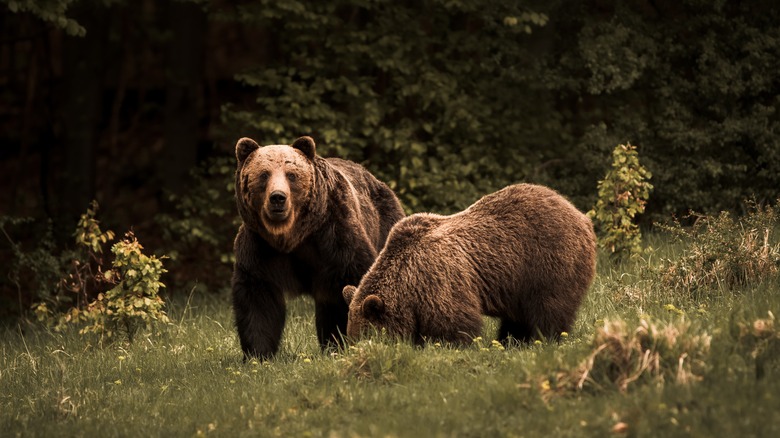Why You Are More Likely To Run Into A Bear During Your Summer Adventures
As you plan your summer outdoor adventures, consider this — if you are heading to almost any wooded or mountainous areas in North America, you are likely to see a bear. Depending on your perception, that could be a positive or a negative. For many people spending time in the woods or outdoors, bears are a serious concern and they take pains to make sure they do not attract bears to their campsites. For others, the opportunity to see a bear in its natural habitat holds a magnetic appeal. Bear viewing has become increasingly popular, partly because people can take and post photos of the bears on social media.
Regardless of whether you are going on a bear-viewing tour, hope to see a bear on your own, or want to avoid them altogether, you are more likely to run into a bear during your summer adventures than at other times of the year. With that in mind, it's not a bad idea to be able to identify dangerous types of bears and know what to do if you are attacked by one such beast before you head on an outdoor excursion in bear territory.
Why are you likely to see one during the summer season? The most obvious reason is the bears are awake, having arisen from their winter slumber in late spring, but there is more to it than that. Here are some other reasons why you are more likely to run into a bear during your summer adventures.
More people are out adventuring during the summer months
Fortunately or unfortunately, depending on how you look at it, a bear's period of awakeness coincides with a period of high outdoor activity by people. This is particularly true in the western and northern sections of the continent — where most bears happen to reside — and for activities such as hiking and camping, the two outdoor activities most likely to result in a bear encounter.
Simple math says if more people are roaming around the mountains and woods where bears live, more people will encounter bears. Add to this equation that the population of some bear species has been increasing, and the odds of a bear encounter have increased even more. Again, depending on your point of view, this can be good or bad. If you hope to catch a glimpse of a bear, summer is an ideal time to plan your adventure. On the other hand, if you are hoping to steer clear of bears while hiking or camping, that may be a bit more of a challenge during summer. However, it is still possible to enjoy your time outdoors and stay safe from bears by following a few bear safety precautions, such as those prescribed by the National Park Service.
Juvenile bears are on their own by summer
During spring and summer, there will also be a new crop of bears exploring the world on their own for the first time, as juvenile bears that had spent the previous summer as cubs following their mother around are now cut free from the apron strings. These younglings act and react differently than the older bears, which isn't much different from humans exploring the world on their own for the first time. As one might expect, they don't have the same level of experience, expertise, and maturity as older bears. So, while looking for food and shelter, they may be more prone to lapses in judgment that put them in closer contact with humans.
Juvenile bears are fairly easy for even amateur bear observers to spot. They also look quite different from older, more mature bears. Younger bears have not filled out, so they are not as bulky as mature bears. Instead, they have a more stringy appearance — long legs and leaner bodies. They also tend to have a smaller head proportionate to their body and ears.
Mating season makes bears travel great distances
The most romantic reason you are more likely to see a bear during your summer adventures is that they are looking for love. In general, adult bears tend to live solitary lives, with the exception of mamma bears tending their cubs. However, they are more likely to be found in pairs during mating season — for obvious reasons. The thing about bear mating season, which usually runs from late spring through summer, is that bears are not monogamous. In fact, both male and female bears are likely to mate with several partners during the mating season. As female bears tend to stick close to home, male bears must cover miles of territory to find suitable mates. Both the distance traveled and the fact that bears have a bit of tunnel vision during mating season lead to more bear sightings this time of year.
However, adventurers should keep in mind that bears also act somewhat differently during mating season. So, whether you want to see a bear or avoid one, you should be aware that bears tend to be more aggressive when pursuing a mate. Although this aggression is generally directed at other bears, it is best to stay a safe distance away.
Baby bears are keeping momma bears busy
While the juvenile bears that have already had a full summer and winter with their momma are now on their own, their younger siblings are not. During summer, mother bears may have as many as a half-dozen extra mouths to feed, depending on how many cubs she birthed during the winter. That means those momma bears will be out and about, working to get enough food for themselves and the little ones. Finding such an ample source of food may, at times, require the family of bears to traverse more terrain than they would otherwise, hence a greater possibility of them being encountered.
Everyone spending any amount of time in bear country should be well aware of this situation, as encounters with mother bears protecting cubs are one of the leading causes of bear attacks. To ensure your safety in the event you find yourself in this situation, never approach or get between a mother bear and her cubs. Give the brood plenty of space and slowly move away from them while maintaining visual contact.
There are plenty of berries for bears to pick during summer
From late spring through summer, berries will become ripe throughout much of North America. A great deal of people enjoy spending a morning or afternoon afield picking these ripening wild fruits. Know who else likes picking and eating wild berries? Bears. Whether it is blueberries, blackberries, raspberries, or any other of the multitude of berries found across the continent, if you spend time during summer in a berry patch in bear country, your likelihood of encountering a bear increases. Also, keep in mind that bears found in a berry patch during summer are likely to be paired up for mating or a mother with her cubs. As mentioned earlier, each of these circumstances increases the danger level of a bear encounter.
The best way to avoid running into a bear in a berry patch? Don't go to pick berries in bear country. However, short of avoiding the activity altogether, here are some pointers for staying safe while picking berries. Pick during the mid-day hours when bears are less active, and make sure you are not alone — pick with a friend or group of friends. Importantly, don't go deep into the berry patch so as to avoid startling any bears resting in the briars.





